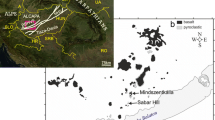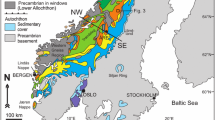Abstract
Felsic to mafic granulite xenoliths from late Neogene basalt pyroclastics in four localities of the western Pannonian Basin (Beistein, Kapfenstein, Szigliget and Káptalantóti (Sabar-hegy) were studied to find out their metamorphic and fluid history. The characteristic mineral assemblage of the granulites consists of Pl + Opx + Qtz ± Cpx ± Bt ± Grt ± Kfs. Based on abundant magmatic relic microstructural domains occurring in these rocks, the potential precursors might have been predominantly felsic igneous or high to ultrahigh temperature rocks. Ternary feldspar thermometry provides a rough estimate of temperatures of about 920–1070 °C. The first fluid invasion event, which is linked with this early high to ultrahigh temperature stage is characterised by primary pure CO2 inclusions in apatite and zircon. The densest primary CO2 inclusions indicate 0.52–0.64 GPa pressure at the estimated temperature range of crystallization. According to mineral equilibria and geothermobarometry, the high to ultrahigh temperature rock cooled and crystallized to granulite of predominantly felsic composition at about 750–870 °C and 0.50–0.75 GPa in the middle crust, between 20 and 29 km depths. The second fluid invasion event is recorded by primary CO2-rich fluid inclusions hosted in the granulitic mineral assemblage (plagioclase, quartz and orthopyroxene). In addition to CO2, Raman spectroscopy revealed the presence of minor N2, H2S, CO and H2O in these inclusions. Partial melting of biotite-bearing assemblages could be connected to the next fluid invasion shown by secondary CO2-rich fluids recorded along with healed fractures in plagioclase, clinopyroxene and orthopyroxene. This event could have happened at depths similar to the previous ones. The final step in the granulite evolution was the sampling in the middle crust and transportation to the surface in form of xenoliths by mafic melt. This event generated temperature increase and pressure decrease and thus, limited melting of the xenoliths. The youngest fluid inclusion generation, observed mostly in healed fractures of felsic minerals, could be associated with this event.





Similar content being viewed by others
References
Balogh K, Árva-Sós E, Pécskay Z (1986) K/Ar dating of post-Sarmatian alkali basaltic rocs in Hungary. Acta Mineral Petrogr Szeged 28:75–93
Balogh K, Lobitzer H, Pécskay Z, Ravasz Cs, Solti G (1990) K/Ar age of tertiary volcanics of Eastern Styria and Burgenland. M Áll Földtani Intézet jelentése Part 1. 451–468. (in Hungarian with English Abstract)
Berkesi M, Hidas K, Guzmics T, Dubessy J, Bodnar RJ, Szabó C, Vajna B, Tsunogae T (2009) Detection of small amounts of H2O in CO2-rich fluid inclusions using Raman spectroscopy. J Raman Spectrosc 40:1461–1463
Brey GP, Köhler T (1990) Geothermobarometry in four phase lherzolites II. New thermobarometers and practical assessment of existing thermobarometers. J Petrol 31:1353–1378. doi:10.1093/petrology/31.6.1313
Brown PE, Lamb WM (1989) P-V-T properties of fluids in the system H2O-CO2-NaCl: new graphical presentations and implications for fluid inclusion studies. Geochim Cosmochim Acta 53:1209–1221
Christensen NI, Mooney WD (1995) Seismic velocity structure and composition of the continental crust: a global view. J Geophys Res 100(B7):9761–9788
Csontos L (1995) Tertiary tectonic evolution of the Intra-Carpathian area: a review. Acta Volcanol 7:1–15
Dégi J, Abart R, Török K, Rhede D, Petrishcheva E (2009) Evidence for xenolith—host basalt interaction from chemical patterns in Fe–Ti-oxides from mafic granulite xenoliths of the Bakony–Balaton Volcanic field (W-Hungary). Miner Petrol 95(3):219–234. doi:10.1007/s00710-008-0035-0
Dégi J, Abart R, Török K, Bali E, Wirth R, Rhede D (2010) Symplectite formation during decompression induced garnet breakdown in lower crustal mafic granulite xenoliths: mechanisms and rates. Contrib Mineral Petrol 159:293–314. doi:10.1007/s00410-009-0428-z
Dobosi G, Downes H, Embey-Isztin A, Jenner GA (2003a) Origin of megacrysts and pyroxenite xenoliths from the Pliocene alkali basalts of the Pannonian Basin (Hungary). Neues Jb Mineral Abh 178:217–238
Dobosi G, Kempton P, Downes H, Embey-Isztin A, Thirlwall M, Greenwood P (2003b) Lower crustal xenoliths from the Pannonian Basin, Hungary. Part 2: Sr-Nd-Pb-Hf and O isotope evidence for formation of continental lower crust by tectonic emplacement of oceanic crust. Contrib Mineral Petrol 144:671–683
Dooley DF, Patiño-Douce AE (1996) Fluid-absent melting of F-rich phlogopite + rutile + quartz. Am Mineral 81:202–212
Downes H, Embey-Isztin A, Thirlwall MF (1992) Petrology and geochemistry of spinel peridotite xenoliths from Hungary: evidence for an association between enrichment and deformation in the mantle. Contrib Mineral Petrol 109:340–354
Embey-Isztin A, Scharbert HG, Dietrich H, Poultidis H (1989) Petrology and geochemistry of peridotite xenoliths in alkali basalts from the Transdanubian Volcanic Region, West Hungary. J Petrol 30(1):79–105
Embey-Isztin A, Scharbert HG, Dietrich H, Poultidis H (1990) Mafic granulites and clinopyroxenite xenoliths from the Transdanubian Volcanic Region (Hungary): implications for the deep structure of the Pannonian Basin. Mineral Mag 54:463–483
Embey-Isztin A, Downes H, James DE, Upton BGJ, Dobosi G, Ingram GA, Harmon RS, Scharbert HG (1993) The petrogenesis of Pliocene alkaline volcanic rocks from the Pannonian Basin, Eastern Central Europe. J Petrol 34(2):317–343
Embey-Isztin A, Downes H, Kempton P, Dobosi G, Thirlwall M (2003) Lower crustal xenoliths from the Pannonian Basin, Hungary. Part 1: mineral chemistry, thermobarometry and petrology. Contrib Mineral Petrol 144:652–670
Fuhrman ML, Lindsley DH (1988) Ternary-feldspar modeling and thermometry. Am Mineral 73:201–215
Grassl H, Neubauer F, Millahn K, Weber F (2004) Seismic image of the deep crust at the eastern margin of the Alps (Austria): indications for crustal extension in a convergent orogen. Tectonophysics 380:105–122
Gross M, Fritz I, Piller W, Soliman A, Harzhauser M, Hubmann B, Moser B, Scholger R, Suttner T, Bojar HP (2007) The neogene of the Styrian Basin—guide to excursions. Joannea Geol Palaeontol 9:117–193
Holloway JR (1981) Compositions and volumes of supercritical fluids in the Earth’s crust. In: Hollister LS, Crawford ML (eds) MAC short course in fluid inclusions, vol 6. Mineralogical Association of Canada, pp 13–38
Horváth F (1993) Towards a mechanical model for the formation of the Pannonian basin. Tectonophysics 226:333–357
Horváth F (1995) Phases of compression during evolution of the Pannonian Basin and its bearing on hydrocarbon exploration. Mar Petrol Geol 12:837–844
Jugovics L (1968) Structure of the Basalt Regions in the Balaton Highland. Yearly Report of the Hung Geol Inst 75–82, Budapest
Kázmér M, Kovács S (1985) Permian-Paleogene paleogeography along the eastern part of the Insubric-Periadriatic lineament system: evidence for continental escape of the Bakony-Drauzug Unit. Acta Geol Hung 28:71–84
Kempton PD, Downes H, Embey-Isztin A (1997) Mafic granulite xenoliths in neogene alkali basalts from the Western Pannonian Basin: insights into the lower crust of a collapsed orogen. J Petrol 38:941–970
Kretz R (1983) Symbols for rock-forming minerals. Am Mineral 68:277–279
Kurat G, Embey-Isztin A, Kracher A, Scharbert HG (1991) The upper mantle beneath Kapfenstein and the Transdanubian Volcanic Region, E Austria and W Hungary: a comparison. Mineral Petrol 44:21–38
McCarthy TC, Patiño-Douce AE (1998) Empirical calibration of the silica-Ca-tschermak’s-anorthite (SCAn)geobarometer. J Metamorph Geol 16:675–686
Mituch E, Posgay K (1972) The crustal structure of Central and Southeastern Europe based on the results of explosion seismology, Hungary. Geophys transactions, Spec Ed 118–129
Mogessie A, Fritz I, Ettinger K, Proyer A (2005) Mantle xenoliths in Neogene volcanic rocks of the Styrian Basin. Mitt Österr Miner Ges 150:265–279
Nair R, Chacko T (2002) Fluid-absent melting of high-grade semipelites: P-T constraints on orthopyroxene formation and implications for granulite genesis. J Petrol 43:2121–2142
Németh K, Martin U (1999) Large hydrovolcanic fi eld in the Pannonian Basin: general characteristics of the Bakony- Balaton Highland Volcanic Field, Hungary. Acta Vulcanol 11:271–282
Newton RC (1989) Metamorphic fluid sin the deep crust. Ann Rev Earth Planet Sci 17:385–412
Panaiotu CG, Pécskay Z, Hambach U, Seghedi I, Panaiotu CE, Tetsumaru I, Orleanu M, Szakács A (2004) Short-lived Quaternary volcanism in the Perşani Mountains (Romania) revealed by combined K-Ar and paleomagnetic data. Geol Carpath 55:333–339
Peterson JW, Newton RC (1990) Experimental biotite-quartz melting in the KMASH-CO2 system and the role of CO2 in the petrogenesis of granites and related rocks. Am Mineral 75:1029–1042
Posgay K, Albu I, Mayerova M, Nakladalova Z, Ibrmajer I, Blizkovski M, Aric K, Gutdeutsch R (1991) Contour map of the Mohorovicic discontinuity beneath Central Europe. Geophys Trans 36:7–13
Santoshi M, Yoshida M (1991) Lützow-Holm Bay: implications for carbonic metamorphism. Mineral J 15(5):175–189
Schneider I (2004) Krusten- und Mantelxenolithe des Steirischen Vulkangebietes – Petrographie und Geochemie. BSc Theses Universität Graz pp 51
Spear FS (2003) Metamorphic phase equilibria and pressure-temperature-time paths. Mineralogical Society of America pp 799
Stegena L, Géczy B, Horváth F (1975) Late Cenozoic evolution of the Pannonian Basin. Tectonophysics 26:71–90
Szabó C, Falus G, Zajacz Z, Kovács I, Bali E (2004) Composition and evolution of lithosphere beneath the Carpathian-Pannonian region: a review. Tectonophysics 393:119–137
Szafián P, Tari G, Horváth F, Cloetingh S (1999) Crustal structure of the Alpine–Pannonian transition zone: a combined seismic and gravity study. Int J Earth Sci 88:98–110
Török K (1995) Garnet breakdown reaction and fluid inclusions in a garnet clinopyroxenite xenolith from Szentbékkálla (Balaton Highland, W-Hungary). Acta Volcanol 7(2):285–290
Török K (2002) Ultrahigh-temperature metamorphism of a buchitised xenolith from the basaltic tuff of Szigliget (Hungary). Acta Geol Hung 45(2):175–192
Török K, Bali E, Szabó C, Szakál JA (2003) Sr-barite droplets associated with sulfide blebs in clinopyroxene megacrysts from basaltic tuff (Szentbékkálla, Western Hungary). Lithos 66:275–289
Török K, Dégi J, Marosi G, Szép A (2005) Reduced carbonic fluids in mafic granulite xenoliths from the Bakony-Balaton Highland Volcanic Field, W-Hungary. Chem Geol 223:93–108
Vaselli O, Downes H, Thirwall MF, Vanucci R, Coradossi N (1996) Spinel-peridotite xenoliths from Kapfenstein (Graz Basin, Eastern Austria): a geochemical and petrological study. Mineral Petrol 57:23–50
Vielzeuf D, Clemens JD (1992) The fluid-absent melting of phlogopite + quartz: experiments and models. Am Mineral 77:1206–1222
Vielzeuf D, Montel JM (1994) Partial melting of metagreywackes. Part I. Fluid-absent experiments and phase relationships. Contrib Mineral Petrol 117:375–393
Vielzeuf D, Schmidt MW (2001) Melting relations in hydrous systems revisited: application to metapelites, metagreywackes and metabasalts. Contrib Mineral Petrol 141:251–267
Wen S, Nekvasil H (1994) SOLVCALC: an interactive graphics program package for calculating the ternary feldspar solvus and for two-feldspar geothermometry. Comp Geosci 20:1025–1040
Wijbrans J, Németh K, Martin U, Balogh K (2007) 40Ar/39Ar geochronology of Neogene phreatomagmatic volcanism in the western Pannonian Basin, Hungary. J Volcanol Geotherm Res 164:193–204
Wopenka B, Pasteris JD (1987) Raman intensities and detection limits of geochemically relevant gas mixtures for a laser Raman microprobe. Anal Chem 59:2165–2170
Yan QZ, Mechie J (1989) A fine structural section through the crust and lower lithosphere along axial region of the Alps. Geophys J 98:465–488
Acknowledgments
The authors kindly acknowledge the support from the Austrian-Hungarian Action Fund (to FK and CSZ). Some of the samples have come from Museum Joanneum, Graz, we are grateful for their contribution.
The authors gratefully appreciate the kind help of Márta Berkesi, Zsanett Pintér and Miklós Veres with the Raman analyses. We wish to acknowledge the two anonymous referees on behalf of the journal for their constructive criticism on the earlier version of the manuscript. A.M. thanks Miss Katharina Kuerbisch for the drawing of Fig. 1c-the sketch of the Styrian Basin. This is the publication N 55 of the LRG, ELTE in collaboration with MFGI and the University of Vienna.
Author information
Authors and Affiliations
Corresponding author
Additional information
Editorial handling: R. Abart
Rights and permissions
About this article
Cite this article
Török, K., Németh, B., Koller, F. et al. Evolution of the middle crust beneath the western Pannonian Basin: a xenolith study. Miner Petrol 108, 33–47 (2014). https://doi.org/10.1007/s00710-013-0287-1
Received:
Accepted:
Published:
Issue Date:
DOI: https://doi.org/10.1007/s00710-013-0287-1




